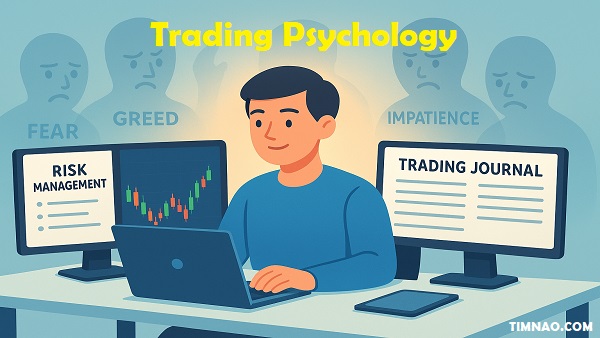Master Your Mind, Master Your Trades: The Shocking Truth About Trading Psychology 🧠💹
Trading psychology is the invisible force that can make or break your success in the markets. While many beginners spend countless hours searching for the perfect strategy or the most advanced indicator, the truth is that your mindset often matters more than your method. How you handle fear, greed, and impulse plays a far greater role in your results than any chart pattern or trading system.
For new traders, this can feel intimidating—but it doesn’t have to be. Developing the right mindset isn’t about being emotionless; it’s about learning how to manage your emotions, build resilience, and stay consistent even when markets get unpredictable. The good news? With simple daily habits, reflection exercises, and proven mindset techniques, anyone can strengthen their mental edge.
In this guide, we’ll break down practical strategies to help you build confidence, avoid emotional traps, and turn trading into a long-term journey instead of a short-lived gamble. Whether you’re just starting or already trading but struggling with discipline, this article will give you clear, actionable steps to master the mental game.
📑 Table of Contents
- 🌍 Why Trading Psychology Matters More Than Strategy
- 🧠 The Hidden Enemies of Traders: Fear, Greed & Impulse
- 💡 Building Emotional Discipline Step by Step
- 📓 The Power of Journaling and Self-Reflection
- 🕰️ Daily Routines to Strengthen Your Trading Mindset
- 🧘 Mindfulness, Breathwork, and Mental Resets for Traders
- 🔄 Turning Losses Into Lessons: Developing Resilience
- 🚀 Practical Exercises for Beginners to Rewire Their Mindset
- 🌟 Final Thoughts: Becoming Your Own Trading Edge
- 🙋 FAQs: Beginner Questions About Trading Psychology Answered
🌍 Why Trading Psychology Matters More Than Strategy
When people first enter trading, they usually put all their energy into finding the perfect strategy. They spend hours watching YouTube tutorials, downloading new indicators, and searching forums for “secret setups.” At first glance, this makes sense—if you know when to buy and when to sell, shouldn’t you always win?
But here’s the harsh truth: a great strategy is useless without the right mindset. Imagine handing the same profitable trading system to ten people. Even if the rules are crystal clear, most will still fail. Why? Because trading success is not only about the system—it’s about the person following it.
Think of trading like driving a car. A powerful sports car can reach high speeds, but if the driver panics, ignores road signs, or makes impulsive turns, accidents are inevitable. The same applies to trading. You might have the “Ferrari” of trading strategies, but if your emotions control your decisions, your results will be inconsistent and painful.
Strategy vs. Psychology: The Key Difference
Let’s say your plan is simple:
- Buy when price crosses above the moving average.
- Sell when it crosses below.
Sounds straightforward, right? But here’s what often happens:
- The price moves up, but you hesitate, afraid it might reverse.
- You finally enter late, then panic and exit too early.
- Or worse, you hold too long because greed tells you “it’s still going.”
The rules didn’t fail—you did. Not because you’re incapable, but because emotions hijacked your decisions.
This is why professional traders often say: “Trading is 80% psychology and only 20% strategy.” Once you master your mind, following your system becomes easier.
Why Beginners Struggle More
As a beginner, emotions feel intensely personal. Losing $50 might feel like a personal attack. Missing out on a big move makes you feel left behind. Winning feels like validation that you’re smart or talented. All of these emotions—fear, greed, pride—create pressure.
The problem is that the market doesn’t care about your feelings. It’s neutral. Your job as a trader is to respond calmly to whatever happens, not to take every move personally. The real challenge isn’t beating the market—it’s beating your own reactions.
If you can stay disciplined when your system says “enter,” confident when it says “exit,” and patient when it says “wait,” then even a simple strategy can bring consistent results. That’s the power of trading psychology.
🧠 The Hidden Enemies of Traders: Fear, Greed & Impulse
Every trader fights an inner battle. The screen may show charts, numbers, and candles, but behind every click of the mouse lies a decision influenced by emotion. Among these emotions, three stand out as the most dangerous for beginners: fear, greed, and impulse.
1. Fear: The Silent Saboteur
Fear takes many forms in trading:
- Fear of losing money makes you avoid good trades or exit too early.
- Fear of missing out (FOMO) pushes you to chase trades that don’t fit your plan.
- Fear of being wrong keeps you holding onto losers, hoping they’ll turn around.
Imagine seeing a perfect setup that matches your plan. Your strategy says “buy,” but your mind whispers, “What if it fails? What if I lose again?” You hesitate, miss the entry, and watch the price skyrocket without you. That’s fear at work—it doesn’t just cost you money; it costs you opportunity.
How to Handle Fear as a Beginner:
- Start small. Trade with position sizes so small that a loss doesn’t shake you emotionally.
- Prepare in advance. Decide your stop-loss and target before entering, so you’re not making decisions in panic mode.
- Journal your fears. Write down what scared you and how it affected your trade. Over time, patterns become clear, and you’ll see that fear often exaggerates the risk.
Fear will always exist in trading—but once you learn to recognize it as just a signal, not a command, you regain control.
2. Greed: The Whisper That Says “Just a Little More”
Unlike fear, greed feels good at first. It often disguises itself as ambition or confidence. After a winning trade, greed tells you: “Stay in a little longer. Add more size. You’re on a hot streak!”
The danger? Greed blinds you to risk. Many beginners have turned a solid winning trade into a painful loss because they didn’t take profit when they should have. Worse, greed pushes traders to increase position sizes beyond their plan, chasing quick riches.
Here’s an example: You planned to make $100 on a trade. When your profit target is reached, greed whispers, “Wait, you can make $200.” You hold on. The price reverses, and suddenly your $100 profit becomes a $50 loss.
How to Handle Greed as a Beginner:
- Define “enough.” Decide on realistic daily or weekly goals and stick to them. Walking away with a win builds confidence and discipline.
- Use alerts. Set take-profit levels in your platform so the system closes the trade for you before greed interferes.
- Reward discipline, not dollars. Celebrate when you follow your plan, regardless of profit. This shifts your mindset from chasing money to building consistency.
Greed might feel like motivation, but in reality, it’s a trap. True success comes from patience and knowing when to step away.
3. Impulse: The Enemy of Patience
Impulse trading is when you enter a trade without a clear plan—just because you “feel” like it. Maybe you saw a sharp move and jumped in. Maybe you were bored and wanted action. Whatever the reason, impulse trades are almost always emotional, not logical.
Impulse often leads directly to revenge trading. After a loss, instead of analyzing calmly, you rush back into the market, desperate to make it back. But this rarely ends well. Most revenge trades only deepen the loss and damage your confidence.
For beginners, impulse trading is especially common because of excitement. The market moves fast, and you feel you need to “do something.” But remember: trading isn’t about action—it’s about patience. Often, the best trade is no trade at all.
How to Handle Impulse as a Beginner:
- Set a daily trade limit. For example, allow yourself a maximum of 2–3 trades per day. This forces you to choose carefully.
- Pause before acting. Whenever you feel the urge to “jump in,” step away for one minute. Ask: “Does this trade fit my plan?” If not, skip it.
- Create a pre-trade checklist. Review it before every trade to make sure you’re not just acting on emotion.
Impulse trading gives the illusion of control, but in reality, it steals discipline. By slowing down and waiting for high-quality setups, you protect both your money and your mindset.
💡 Building Emotional Discipline Step by Step
When people hear the word “discipline” in trading, they often imagine being completely emotionless, like a robot. But that’s not realistic. You’ll always feel emotions when money is at stake. The key isn’t to eliminate feelings—it’s to control your reactions so emotions don’t control your decisions.
Think of emotional discipline as a muscle. You don’t build it overnight. You strengthen it gradually, one decision at a time. Let’s walk through some practical steps to help beginners develop this skill.
Step 1: Create Clear Rules Before You Trade
Discipline is much easier when decisions are made before emotions enter the picture. Before you enter the market, set:
- Your entry point.
- Your stop loss.
- Your target price.
- The maximum you’re willing to risk (usually 1–2% of your account).
If you write these rules down in advance, you won’t need to decide “in the heat of the moment.” Instead, you’ll simply follow your pre-defined plan.
Beginner Tip: Think of your rules as a seatbelt. You may not need it every time, but when things go wrong, it can save you from a disaster.
Step 2: Focus on Process, Not Profits
Most beginners measure success by how much money they made in a single trade. But chasing profits can lead to greed, frustration, and reckless choices. Instead, shift your mindset: a good trade is one where you followed your plan, even if it lost money.
Professional traders often say: “Take care of the process, and the profits will take care of themselves.” By focusing on discipline rather than dollar amounts, you reduce the emotional rollercoaster and build consistency over time.
Step 3: Develop a “Pause Routine”
Emotions spike quickly in trading. One moment you’re calm, the next you’re panicking or euphoric. To prevent impulsive decisions, build a small pause into your routine.
Here’s a simple method:
- Before entering a trade, take a deep breath.
- Ask yourself: “Does this trade match my rules, or am I acting on emotion?”
- If you’re unsure, step away for one minute.
This short pause helps you catch yourself before making costly emotional moves. Over time, it becomes a natural habit.
Step 4: Limit Risk to Limit Emotion
The bigger the risk, the stronger the emotions. If you risk half your account on one trade, of course you’ll feel terrified. But if you risk only 1% or 2%, even a loss feels manageable.
Lowering your risk isn’t just about protecting money—it’s about protecting your mental balance. When you know a single trade won’t ruin you, you can think more clearly and act more rationally.
Step 5: Build Discipline With Small Wins
Discipline grows when you see proof that it works. Start small:
- Commit to following your plan for five trades in a row.
- Reward yourself (not with riskier trades, but with something simple like taking a break or writing down your achievement).
Each time you stick to your plan, you build confidence in your ability to stay disciplined. And confidence reduces emotional pressure.
Step 6: Accept That Losses Are Normal
One of the hardest lessons for beginners is realizing that even with discipline, you will lose sometimes. Losses are not signs of failure—they’re part of the game.
If you can accept losses as “the cost of doing business,” you’ll stop fearing them. This acceptance is the final piece of emotional discipline. It frees you to focus on execution instead of obsessing over outcomes.
📓 The Power of Journaling and Self-Reflection
While discipline helps you manage emotions in real time, journaling and reflection help you understand them afterward. Without reflection, it’s easy to repeat the same mistakes over and over. With a trading journal, you transform each trade into a learning opportunity.
Why Beginners Need a Journal
As a beginner, your memory will play tricks on you. You may remember your biggest wins and losses, but forget the dozens of small decisions that shaped them. A journal captures the full picture—your thoughts, emotions, and behaviors—so you can spot patterns over time.
For example, you might discover that you often exit too early after two losing trades in a row. Or that you take impulsive trades late at night when you’re tired. These insights are invisible unless you write them down.
What to Include in Your Trading Journal
Your journal doesn’t need to be fancy. A simple notebook, spreadsheet, or app will do. Here’s what to record for each trade:
- Basic Details – Date, asset, entry/exit, position size, result.
- Reason for Entry – Why did you take this trade? Did it fit your rules?
- Emotions Felt – Nervous, confident, greedy, fearful?
- Outcome – Win/loss, but also whether you followed your plan.
- Lesson Learned – What can you improve next time?
By combining numbers with emotions, you build a full picture of both your strategy and your psychology.
Example of a Beginner Journal Entry
- Trade: Bitcoin, long at $25,000.
- Reason: Trend continuation setup from my plan.
- Emotions: Nervous because last two trades were losses. Exited early out of fear.
- Outcome: Small profit, but price went higher. Missed larger gain.
- Lesson: Fear of recent losses made me exit too soon. I need to trust my plan more.
Over time, several entries like this will reveal a clear pattern: fear of past losses leads to premature exits. With this awareness, you can create a rule: “I will not exit early unless my stop-loss is hit.”
The Reflection Habit
The journal only works if you review it consistently. At the end of each week:
- Look for repeated emotional triggers.
- Count how many trades followed your plan versus how many didn’t.
- Write one goal for next week, such as: “Stay in trades until stop-loss or target is hit.”
This weekly reflection transforms trading into a structured learning process instead of random trial and error.
Tools That Can Help
- Excel or Google Sheets: Great for numbers and charts.
- Notion or Evernote: Perfect for combining text notes with screenshots.
- Dedicated trading journals like TraderSync or Edgewonk, which analyze your trades automatically.
Pick whatever feels easiest to maintain. The most important thing is consistency, not complexity.
🕰️ Daily Routines to Strengthen Your Trading Mindset
Trading is not just about strategies and charts—it’s about preparation and consistency. Just like athletes warm up before a game, traders need routines that put their mind in the right state. Without routines, it’s easy to slip into emotional trading, making decisions based on fear, greed, or boredom.
A solid daily routine acts as a mental anchor. It reduces stress, minimizes impulsive decisions, and keeps you focused on long-term goals rather than short-term emotions.
Why Routines Matter
The market is unpredictable. Prices can rise or crash in seconds. Without structure, beginners often end up glued to screens, chasing every movement, and burning out quickly. A daily routine brings order to this chaos.
More importantly, routines reduce decision fatigue. The fewer unnecessary choices you have to make, the more energy you can reserve for critical trading decisions. By automating parts of your day, you keep your focus sharp where it matters most.
Pre-Market Routine: Start With Clarity
How you begin your trading day shapes your mindset. Instead of rushing straight into charts, create a calm and deliberate start:
- Check your mental state: Ask yourself, “Am I calm and focused, or stressed and distracted?” If you’re not in the right frame of mind, it may be better to trade less or not at all that day.
- Review your trading plan: Write down what setups you’ll look for. Having clarity before the market opens reduces impulsive decisions later.
- Set goals for the day: Focus on process goals, like “follow my rules,” instead of outcome goals like “make $100.”
- Do a quick reset: Try 5 minutes of breathing, stretching, or light exercise to reduce stress and boost focus.
This small ritual trains your brain to shift from “daily life mode” to “trading mode.”
During-Market Routine: Stay Disciplined
Once trading begins, your routine should help you stick to your plan and avoid emotional traps. Here are a few habits that work well:
- Trade only when conditions match your plan. If no setup appears, don’t force a trade.
- Set alerts. Instead of staring at the screen for hours, let your platform notify you when price reaches key levels.
- Take mini breaks. After a trade—win or lose—step away for a few minutes. This resets your mind and prevents revenge trading.
- Limit your number of trades. Decide a daily maximum (like 3 trades). This forces you to choose quality over quantity.
By following a structure, you avoid falling into the trap of “overtrading” and protect both your account and your mindset.
Post-Market Routine: Review and Reset
Many beginners forget that what happens after the market closes is just as important as what happens during trading. Use the end of the day to reflect and improve:
- Journal your trades. Note not only profits and losses but also your emotions and decision-making.
- Identify lessons. Ask: “Did I follow my plan? What emotion influenced me most today?”
- Set a small improvement goal for tomorrow. Example: “I will not exit early unless my stop-loss is hit.”
- Disconnect. Once your review is done, step away. Don’t obsess over charts all night—your mind needs rest to recover.
This review ritual builds self-awareness and ensures every day adds to your growth as a trader.
Sample Beginner-Friendly Routine
Here’s a simple day structure you can adapt:
- 8:30 AM: 5 minutes of breathing, review trading plan.
- 9:00 AM: Market opens. Watch only for planned setups.
- 10:00 AM: Enter trade if setup appears. Note emotions.
- 10:15 AM: After trade, take a short break.
- 1:00 PM: Second market check, possible trade.
- 4:00 PM: Market close. Journal entries + lessons.
With time, you can adjust this to fit your personal schedule. The key is consistency—routines only work if repeated daily.
🧘 Mindfulness, Breathwork, and Mental Resets for Traders
Even with routines, trading is stressful. Prices move fast, losses sting, and wins can trigger greed. This emotional intensity can quickly lead to burnout if you don’t have tools to manage it.
This is where mindfulness and breathwork come in. These simple practices help you stay calm, focused, and balanced—even during stressful market moves.
What Is Mindfulness in Trading?
Mindfulness is the ability to stay fully present in the moment without judgment. In trading, this means observing the market and your emotions without immediately reacting to them.
For example, instead of panicking when a trade moves against you, mindfulness helps you notice the fear, acknowledge it, and then calmly follow your plan. It’s about responding with clarity, not reacting impulsively.
Practical Mindfulness Exercises for Traders
You don’t need hours of meditation. A few minutes each day can make a huge difference. Here are some simple ways to start:
- 2-Minute Breathing Break: Before entering a trade, close your eyes and take slow, deep breaths for two minutes. Focus on your breath to clear distractions.
- Body Scan: Quickly notice areas of tension (shoulders, jaw, hands). Relax them before continuing.
- Chart Observation Without Action: Spend 5 minutes looking at the chart without taking any trades. Just observe. This reduces the urge to act impulsively.
These small practices train your brain to pause and think clearly under pressure.
Breathwork for Stress Control
Breathing is the simplest yet most powerful tool for controlling emotions. When you’re anxious, your breath becomes shallow and fast. By slowing it down, you send signals to your nervous system that you are safe, reducing stress.
Here are two effective techniques:
- Box Breathing (4-4-4-4): Inhale for 4 seconds → Hold for 4 seconds → Exhale for 4 seconds → Hold for 4 seconds. Repeat 3–4 times.
- Extended Exhale: Inhale for 4 seconds → Exhale for 6–8 seconds. This helps calm nerves quickly during volatile market moves.
Practice these before and during trading sessions to stay centered.
Mental Resets: Recovering After Stressful Trades
Even disciplined traders face stressful moments. A big loss, a string of losing trades, or missing out on a major move can shake your confidence. That’s why you need mental reset rituals.
Here are a few effective resets:
- Step Away: After a difficult trade, physically leave your desk. A short walk clears your head better than staring at the screen.
- Write It Out: Jot down what happened, how you felt, and what you’ll do differently next time. This turns frustration into learning.
- Physical Movement: Quick stretches, push-ups, or even pacing around the room help release emotional tension.
- Reset Timer: Give yourself a rule—after a losing trade, wait 15 minutes before considering another. This prevents revenge trading.
These resets protect your mindset so that one bad trade doesn’t spiral into a bad trading day.
Building Mental Strength Over Time
Mindfulness, breathwork, and resets are like mental workouts. At first, they may feel awkward or unnecessary. But over time, they strengthen your ability to stay calm and consistent, even in volatile markets.
The goal isn’t to never feel emotions—it’s to recognize them quickly and choose your response. This is what separates beginners who struggle from traders who grow steadily.
🔄 Turning Losses Into Lessons: Developing Resilience
Every trader faces losses. It doesn’t matter if you’re a complete beginner or a seasoned professional—losses are part of the game. The difference between struggling traders and successful ones isn’t avoiding losses, but how they respond to them.
For beginners, this can be tough. The first few losses often feel personal, as if they reveal you’re “bad at trading.” But in reality, a single trade means nothing in the big picture. What matters is whether you can bounce back, learn, and keep improving. That ability to recover and adapt is called resilience.
Why Losses Hurt So Much
Losses sting because they trigger strong emotions:
- Fear – “What if I lose all my money?”
- Shame – “I should have known better.”
- Frustration – “I was so close to profit, why did I exit early?”
These emotions are natural, but if left unmanaged, they can lead to revenge trading, overleveraging, or quitting too soon. Resilience doesn’t mean ignoring the pain—it means reframing it so you grow stronger instead of weaker.
Reframing Losses as Tuition
Think of trading losses as tuition fees—the price you pay to learn. Just like doctors and lawyers invest years in school, traders “pay” the market while developing skill. Instead of labeling a loss as failure, view it as an investment in your growth.
For example:
- If a trade fails because you didn’t follow your plan → the lesson is discipline.
- If it fails because of unexpected news → the lesson is risk management.
- If it fails despite following your plan → the lesson is that probabilities, not certainty, rule the market.
By reframing losses this way, you reduce emotional weight and focus on growth.
The “One Trade Means Nothing” Mindset
Professional traders remind themselves that no single trade defines them. Trading is about long-term probabilities, not short-term wins. If your edge plays out over 100 trades, then one bad result is just a tiny piece of the puzzle.
Here’s a simple mantra: “One trade means nothing. My results come from consistency, not luck.” Repeat this after both wins and losses to keep your mindset balanced.
Building Resilience With Recovery Habits
Resilience isn’t automatic—it’s built through small habits that help you recover after setbacks. Here are some effective ones:
- Pause Before Reacting
After a big loss, take a short break. Don’t immediately jump back into the market. This prevents revenge trading. - Write It Down
Journal what happened, how you felt, and what you’ll do differently. Writing turns emotions into lessons. - Lower Your Risk Temporarily
If you’re shaken after losses, cut position size for the next few trades. This helps rebuild confidence without heavy pressure. - Celebrate Following the Plan
Even if a trade loses, reward yourself if you stuck to your rules. This builds trust in your process.
By practicing these habits, you turn losses from destructive events into stepping stones for improvement.
🚀 Practical Exercises for Beginners to Rewire Their Mindset
Resilience is about bouncing back, but true growth comes from actively training your mindset. Just like you lift weights to build muscles, you can practice exercises that strengthen discipline, patience, and emotional control.
Here are simple, beginner-friendly exercises to rewire your trading psychology.
1. The “Trade Replay” Exercise
After every trading session, replay one trade in your mind—or even on your chart platform—and ask yourself:
- Did I follow my plan?
- What emotion was strongest?
- If I faced this situation again, how would I act differently?
This mental replay is like watching sports footage. Athletes improve by reviewing plays, and traders improve by reviewing trades.
2. Small Risk Exposure Training
Fear often comes from risking too much. To train yourself, deliberately take very small trades (like risking $5 or $10). The goal isn’t profit—it’s practicing staying calm, following rules, and managing emotions.
This teaches your brain that losing isn’t dangerous and builds confidence slowly, without heavy financial pressure.
3. Emotional Labeling
During trading, pause and name your emotion out loud or in your notes:
- “I feel anxious.”
- “I feel greedy.”
- “I feel impatient.”
Labeling emotions reduces their power. It shifts your brain from reacting automatically to observing calmly. Over time, this habit helps you catch emotional triggers before they sabotage trades.
4. Pre-Commitment Rituals
Before trading, write down one specific behavioral goal, such as:
- “I will not move my stop-loss.”
- “I will not enter trades outside my plan.”
After the session, review whether you stuck to that commitment. This simple ritual strengthens discipline by making you accountable to yourself.
5. Visualization Practice
Spend 5 minutes visualizing yourself trading calmly and following rules. Imagine scenarios where price moves against you, and see yourself responding with discipline. Athletes use visualization to prepare mentally—traders can too.
This exercise trains your mind to act with control, even before the real situation happens.
6. Gratitude Reset
Trading can feel like an emotional rollercoaster. To balance your mindset, finish each trading day by writing three things you’re grateful for. They don’t need to be trading-related—just anything positive.
Gratitude resets your perspective, prevents burnout, and reminds you that your self-worth is not tied to your trading results.
7. The “Next Trade Mentality”
After a win or a loss, remind yourself: “The only trade that matters is the next one.” This keeps you from getting overconfident after wins or desperate after losses.
Write this on a sticky note near your desk as a constant reminder.
🌟 Final Thoughts: Becoming Your Own Trading Edge
Most beginners believe the secret to success in trading lies in finding the perfect strategy, the best indicator, or the latest AI-powered tool. While these things can help, the real secret is simpler—and far more powerful: you are the edge.
Your ability to manage emotions, stick to routines, and learn from mistakes determines whether your strategy succeeds or fails. Two traders can use the exact same system and end up with completely different results, simply because one had the discipline to follow the plan while the other let fear or greed take over.
Why Psychology Outweighs Strategy
Think of trading strategies as cars. Some are fast, some are reliable, some are complex. But no matter how advanced the car is, it won’t reach the destination without a skilled driver. You are that driver. Psychology is your steering wheel.
That’s why seasoned traders often say: “It’s not the strategy, it’s the trader behind it.” With the right mindset, even a simple approach can work. Without discipline, even the most sophisticated system will fail.
Becoming Resilient, Disciplined, and Confident
Throughout this guide, we’ve covered the building blocks of trading psychology:
- Resilience to recover from losses.
- Discipline to follow your plan.
- Confidence to trust your process over short-term results.
These qualities don’t appear overnight. They are built daily—through routines, journaling, mindfulness, and small mindset exercises. The more you practice, the more natural they become.
Trading as a Lifelong Journey
Unlike jobs with fixed learning paths, trading is an endless process of growth. Markets change, strategies evolve, and your personal psychology shifts over time. The traders who last are not those chasing shortcuts but those willing to learn continuously.
If you view trading as a journey rather than a quick money-making scheme, you’ll not only survive but thrive. Success comes from progress, not perfection. Each mistake is a teacher, each win a motivator, and each day an opportunity to improve.
Your Edge Is You
At the end of the day, remember this: markets don’t reward the smartest person in the room—they reward the most consistent. And consistency comes from mindset. By investing in your psychology, you’re building the one edge no one else can copy.
You are your own trading edge.
🙋 FAQs: Beginner Questions About Trading Psychology Answered
Beginners often struggle with the same questions when it comes to trading psychology. Let’s clear up some of the most common ones so you can avoid confusion and start with clarity.
1. Why does trading feel so emotional compared to other activities?
Because money is tied to survival, freedom, and status. When money is at risk, your brain reacts as if your safety is threatened. That’s why losses trigger panic and wins spark euphoria. Recognizing this is normal helps you separate emotions from rational decisions.
2. Can I completely eliminate emotions from trading?
No—and you shouldn’t try to. The goal isn’t to be emotionless but to manage emotions. Even top traders feel fear and greed. The difference is that they have systems—like journaling, routines, and breathwork—that prevent emotions from dictating their actions.
3. How do I stop revenge trading after a loss?
The key is to pause and reset. Create a rule for yourself: after any loss, wait at least 15 minutes before entering another trade. Use that time to journal what happened and calm down. Over time, this “cooling-off” habit reduces emotional spirals.
4. What if I don’t have much time for journaling and routines?
Even five minutes a day can help. A quick note on why you entered a trade and how you felt is better than nothing. The same goes for routines—just reviewing your plan and taking two deep breaths before trading can improve your mindset dramatically.
5. How can I build confidence as a beginner?
Confidence comes from small wins, not big ones. Focus on following your plan rather than making money. Each time you stick to your rules, even if the trade loses, you strengthen your confidence. Over time, this creates trust in yourself and your system.
6. What’s the fastest way to improve trading psychology?
There’s no overnight fix, but one powerful shortcut is risk management. By lowering your risk per trade to a small percentage (like 1–2% of your account), you reduce the emotional weight of each decision. With less fear, discipline becomes easier to maintain.
7. Should I learn psychology first or strategy first?
They go hand in hand, but many traders learn strategy first and neglect psychology—only to discover later that mindset is what holds them back. As a beginner, practice both: build simple strategies and simultaneously work on discipline, journaling, and routines.
8. Do professional traders still struggle with emotions?
Yes. The difference is they’ve developed tools to manage them. Even hedge fund managers experience fear during market crashes, but they rely on discipline, preparation, and resilience to act rationally despite their feelings.
9. What if I fail at trading psychology?
You won’t “fail” if you treat it as practice. Everyone slips—moving a stop-loss, chasing a trade, exiting too early. The key is to reflect, learn, and keep going. Failure only happens if you give up entirely.
10. How long does it take to build strong trading psychology?
It varies for everyone, but most beginners start seeing improvements within a few months of consistent practice. Like fitness, results come from daily effort, not one-time fixes. The more you commit to routines and reflection, the faster your growth.
📌 Disclaimers
- Educational Purposes Only
The information in this article is provided for educational and informational purposes only. It should not be considered financial or investment advice. - No Guaranteed Results
Trading in financial markets involves risk. Past performance does not guarantee future results, and no strategy or psychological practice can eliminate the possibility of losses. - Personal Responsibility
Readers are encouraged to conduct their own research and, if necessary, seek guidance from a licensed financial advisor before making trading or investment decisions. - Risk Warning
Trading with leverage or speculative products (such as forex, options, or cryptocurrencies) carries a high level of risk and may not be suitable for all investors. Only trade with money you can afford to lose. - Affiliate/External Links
Some external links mentioned in this article may direct you to third-party tools or platforms. We do not control, endorse, or guarantee the accuracy or safety of those external resources.









